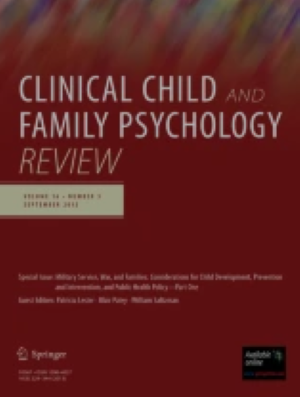The Efficacy of Acceptance and Commitment Therapy for Transitional-Age Youth: A Meta-analysis.
IF 6.1
1区 心理学
Q1 PSYCHOLOGY, CLINICAL
引用次数: 0
Abstract
This meta-analysis integrated the findings on the efficacy of acceptance and commitment therapy (ACT) for transitional-age youth (TAY; youth aged 15 to 25) on psychopathology (i.e., internalizing, externalizing and other psychological problems), ACT related processes (i.e., psychological flexibility and self-compassion), well-being (i.e., general and social well-being) and coping (i.e., emotional and cognitive coping). Additionally, we used meta-regression analyses to examine whether effect sizes varied based on the type of (sub) outcome, timing of assessment, various intervention characteristics, type of control group and several sample characteristics. We executed a three-level meta-analytic model in R. Based on 65 studies (n = 5283), we found a moderate effect (Hedges's g = 0.72) of ACT compared to the control conditions on psychopathology, ACT related processes, well-being and coping. The quality of the evidence was very low due to a relatively high risk of bias in the selected studies, considerable heterogeneity in effect sizes and a risk of publication bias. Regarding the meta-regression analyses, we found that ACT was more effective than waitlist and TAU conditions, but equally effective compared to CBT, other treatments (e.g., Rational Emotive Behavior Therapy) and other control conditions (e.g., educational intervention). Our results suggest that ACT is an effective intervention for reducing psychopathology and increasing ACT related processes, well-being and coping in TAY with diverse types and severity of psychological problems. We recommend future research to conduct more high quality research, including larges samples, active control conditions, longer follow-up periods and measures of treatment integrity, in more diverse populations of TAY.接纳与承诺治疗对过渡年龄青年的疗效:一项元分析。
本meta分析综合了接受与承诺治疗(ACT)对过渡年龄青年(TAY; 15 - 25岁青年)在精神病理(即内化、外化和其他心理问题)、ACT相关过程(即心理灵活性和自我同情)、幸福感(即一般幸福感和社会幸福感)和应对(即情绪应对和认知应对)方面的疗效。此外,我们使用元回归分析来检验效应大小是否根据(子)结局类型、评估时间、各种干预特征、对照组类型和几个样本特征而变化。基于65项研究(n = 5283),我们发现与对照条件相比,ACT在精神病理、ACT相关过程、幸福感和应对方面具有中等影响(Hedges g = 0.72)。由于所选研究的偏倚风险相对较高,效应大小存在相当大的异质性,并且存在发表偏倚的风险,因此证据的质量非常低。关于meta回归分析,我们发现ACT比候补名单和TAU条件更有效,但与CBT、其他治疗(如理性情绪行为治疗)和其他控制条件(如教育干预)相比同样有效。我们的研究结果表明,ACT是一种有效的干预措施,可以减少心理病理,增加与ACT相关的过程,幸福感和应对不同类型和严重心理问题的TAY。我们建议未来的研究进行更多高质量的研究,包括大样本、主动控制条件、更长的随访期和治疗完整性措施,在更多样化的TAY人群中进行。
本文章由计算机程序翻译,如有差异,请以英文原文为准。
求助全文
约1分钟内获得全文
求助全文
来源期刊

Clinical Child and Family Psychology Review
PSYCHOLOGY, CLINICAL-
CiteScore
10.50
自引率
4.30%
发文量
45
期刊介绍:
Editors-in-Chief: Dr. Ronald J. Prinz, University of South Carolina and Dr. Thomas H. Ollendick, Virginia Polytechnic Institute Clinical Child and Family Psychology Review is a quarterly, peer-reviewed journal that provides an international, interdisciplinary forum in which important and new developments in this field are identified and in-depth reviews on current thought and practices are published. The Journal publishes original research reviews, conceptual and theoretical papers, and related work in the broad area of the behavioral sciences that pertains to infants, children, adolescents, and families. Contributions originate from a wide array of disciplines including, but not limited to, psychology (e.g., clinical, community, developmental, family, school), medicine (e.g., family practice, pediatrics, psychiatry), public health, social work, and education. Topical content includes science and application and covers facets of etiology, assessment, description, treatment and intervention, prevention, methodology, and public policy. Submissions are by invitation only and undergo peer review. The Editors, in consultation with the Editorial Board, invite highly qualified experts to contribute original papers on topics of timely interest and significance.
 求助内容:
求助内容: 应助结果提醒方式:
应助结果提醒方式:


